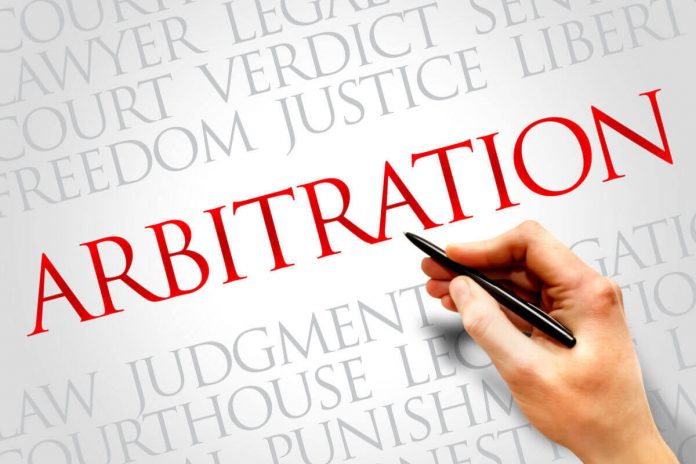This article has been written by Neha Dahiya and is further updated by Rachel Sethia. This article explains the meaning, essential requirements, stages of proceedings, and advantages of international arbitration. It also covers the international conventions and forums regulating international arbitration. The article further talks about the key differences between international and domestic arbitration. In addition to that, the article also puts an emphasis on the evolution, need, rules, Indian laws vis a vis international arbitration, emerging issues with the same, and cyber security pertaining to international arbitration.
It has been published by Rachit Garg.
Table of Contents
Introduction
Globalisation has brought the world closer. It has facilitated cross-country contracts where people from different corners of the world can come together and carry out different forms of commercial and non-commercial activities. In such cases, disputes arising between the parties are common phenomena. International arbitration provides a simple, inexpensive, and efficient method of dispute resolution between parties belonging to different nationalities. It involves the appointment of a neutral person called the arbitrator to decide on the dispute between the parties as per the procedure agreed upon by the parties, outside the ambit of the domestic courts. International arbitration provides a more neutral platform than the domestic courts that follow the law of a particular state. Arbitration tribunals, on the other hand, are private institutions that are not bound by any particular country’s laws and can efficiently deal with disputes arising from transnational transactions.
What is arbitration
The most accepted meaning of arbitration is that it is a process in which the parties involved consensually agree to present the dispute to a non-governmental decision-maker known as an arbitrator. The arbitrator then carries out neutral adjudicative proceedings, giving all the parties the opportunity to be heard and make a binding decision in the end. Thus, there is no role for the courts established by law in arbitration cases. The process of arbitration is usually less time-consuming and less formal. Arbitration is a type of alternative dispute resolution system that is preferred by most people and businesses. It has many benefits, like flexibility, time efficiency, privacy, and many more, but with so many benefits, the bigger question that arises is whether to pursue litigation or arbitration for your case to which the answer depends on the nature, facts, and circumstances of your case.
What is international arbitration
International arbitration is a dispute resolution mechanism, similar to domestic court litigation, except it is carried out by private adjudicators called ‘arbitrators,’ and it extends beyond a country’s borders. It is a consensual, neutral, binding, and enforceable means of dispute resolution that is more efficient and faster than regular court proceedings. It facilitates the coming together of parties from different legal, linguistic, and cultural backgrounds and resolving their disputes.
Availing international arbitration can be optional, but it could also be made compulsory by inserting a ‘mandatory arbitration clause.’ Usually, parties enter into ‘arbitration agreements’ beforehand. Article II(1) of the New York Convention defines such an agreement as “an agreement in writing under which the parties undertake to submit to arbitration all or any differences which have arisen or which may arise between them in respect of a defined legal relationship, whether contractual or not.”
Thus, international arbitration, “provides businesses engaged in international transactions with a neutral form of dispute resolution.”
Essential requirements of an international arbitration clause
An international arbitration clause, a cornerstone of cross-border contracts, delineates the framework for resolving disputes outside the traditional courts system. Crafted with meticulous detail, these clauses outline critical elements such as the choice of arbitral institution, designated seat of arbitration and the governing law. Parties may stipulate the number of arbitrators, the language of proceedings and provisions confidentiality. Financial considerations, including cost and fees allocation, are addressed alongside mechanisms for entering measures and emergency relief. Importantly, the enforceability of arbitral awards across jurisdictions is carefully considered, ensuring the efficacy of the dispute resolution process. International arbitration clauses tailor to the unique needs of each contract, serve as vital safeguards against potential conflicts, promoting stability and certainty in global business transactions.
International arbitration clause to be in writing
In most jurisdictions, enforcing an arbitration agreement typically requires it to be documented in writing. This is also prescribed in Article 7 of the UNCITRAL Model Law.
International arbitration to be mandatory
The intention of the parties regarding taking the dispute to arbitration must be clear from the agreement clause. It may provide for mandatory arbitration in case of any dispute or contain permissive language, i.e., that any dispute may be referred to arbitration. In some cases, there may be a clause for unilateral choice of arbitration, i.e., either party may unilaterally choose between arbitration or court proceedings in case a dispute arises. However, these clauses are not enforceable in all jurisdictions.
In recent years, mandatory arbitration clauses have become a problem. Corporations usually insert mandatory arbitration clauses in agreements with consumers and employees. The problem that arises here is that these clauses take away the jurisdiction of domestic courts in case any dispute arises. Thus, the employees and consumers have no recourse left to the country’s judicial system; rather, they have to go for arbitration, which practically puts them in a disadvantaged position. That is why the relevance of such clauses has been disputed across the world recently.
Choice of the arbitral seat
The choice of arbitral seat is related to the country whose courts shall have supervisory jurisdiction over the arbitration proceedings. These courts of the arbitral seat have the authority to pass rulings on preliminary injunctions and any challenges related to the arbitral award. However, the arbitral seat is not the same as the venue of the arbitration, i.e., it need not correspond with the place where the hearings physically take place for these reasons, it is important to choose a seat in a place that has modern and arbitration-friendly laws and where the courts are cognizant of international arbitration principles to ease the entire process.
A pertinent case to mention here is that of the BALCO judgment. In Bharat Aluminium Company v. Kaiser Aluminium Technical Services Inc.(2012), it was held that Part I of the Arbitration and Conciliation Act, 1996 would not apply to the foreign-seated international commercial arbitrations. Section 2(2) of the Act outlines the territorial limitations of the Act, i.e., it applies only to arbitration seated in India. Thus, different countries have different laws regarding the arbitrations carried out on their soil or outside. The choice of the arbitral seat has serious consequences, including the applicability of domestic laws and the enforceability of the award.
Scope of the clause
It is important to clarify the scope of the arbitration clause so as to definitely outline the disputes arising out of, or in connection with the agreement that can be made the subject of arbitration, regardless of the types of claims asserted, like contract breach, business tort claim, etc. The parties may choose to keep certain claims like infringement of intellectual property rights, etc. out of the arbitration clause. In such cases, the claims left out may be preferred to any court of competent jurisdiction. Also, the matters that can be referred to arbitration may also differ according to the arbitral seat. Some jurisdictions prescribe that certain matters should be mandatorily resolved by courts of competent jurisdiction, and not referred to arbitration.
Applicable laws
The arbitration clause must also specify the substantive law to be applicable to the rights and obligations arising under the contract if they are not dealt with under any other relevant provision within the contract. The applicable law need not have any relation to the arbitral seat.
Arbitral rules
In case the parties wish to get their dispute resolved by a specific international arbitral institution, like the International Chamber of Commerce, the arbitration clause must specify that particular arbitral institution and the institutional rules as well.
Language of the proceedings
In international arbitration, the language of the proceeding is mostly decided by the parties to arbitration. However, if the parties have not agreed upon the language of the arbitration then, the decision falls to the arbitral tribunal. The tribunal will consider various factors which will include the language closely related to the language of the contract, the convenience and cost implication of that language, the language skills of the parties and their representative or any other important circumstance. The tribunal will usually issue a procedural order or ruling on tha matter detailing the language to be used for the proceeding.
Optional clauses
The following details, though optional, may be included in the international arbitration clause:
- The number of arbitrators, or their specific qualifications;
- The method of constituting a tribunal;
- Rules regarding the confidentiality of the proceedings;
- Allocation of the costs of arbitration;
- Mandatory pre-arbitration negotiations or mediation;
- Waiver of the right to challenge the arbitral award, adhering to the limits permitted under the law of the arbitral seat;
- Powers of the tribunal to call for specific performance of the contract; or
- Other specifics related to the dispute or arbitration.
Evolution of international arbitration
Arbitration has ancient roots, but these earlier forms of arbitration were rather more informal and were primarily based on customs. As trade and commerce expanded globally, businesses sought alternative dispute resolution mechanisms to resolve their disputes arising out of a commercial transaction and due to the added features like neutrality, flexibility, and convenience, arbitration turned out to be the most reliable process for the resolution of disputes. The modern era of international arbitration began in the late 19th century with the establishment of institutions like the Permanent Court of Arbitration and the International Chambers of Commerce.
The Hague Convention of 1899 laid the groundwork for international arbitration, among other things, by making rules and procedures for the resolution of disputes through international arbitration. The major evolution with respect to International Arbitration was the adoption of the United Nations Convention on the Recognition and Enforcement of Foreign Arbitral Awards (1958) which facilitates the recognition and enforcement of arbitral awards across national borders, enhancing the enforceability and effectiveness of international arbitration. In addition to addressing arbitration, the said convention aimed to promote international cooperation, disarmament and peaceful settlement of disputes through diplomacy and arbitration. Therefore, the convention played a crucial role in advancing international arbitration, its broader objective encompassed various aspects of international law and conflict resolution beyond arbitration alone.
The Convention for Pacific Settlement of International Dispute (1899) was also adopted in the Hague Convention. It established a mechanism for arbitration, conciliation and judicial settlement of international disputes. This convention has played a vital role in the development of international arbitration, as it formalised rules and procedure for resolving disputes amongst the states.
In the 20th century, investor-state arbitration gained prominence with bilateral and multilateral investment treaties. These treaties afford foreign investors the right to commence arbitration proceedings against the host state in case of treaty violation, ultimately culminating in the establishment of the International Centre for Settlement of Investment Disputes in 1966. This centre provides a neutral form for the settlement of investment disputes, primarily between investor and state, it aims to promote investment flows and economic development by providing fair, efficient and neutral mechanisms for resolving disputes arising out of international investment agreements, treaties, and contracts. In response to the evolving economic, political and legal landscapes, international arbitration has adapted. There has been a notable rise in the utilisation of technology, including advancement in e-arbitration proceedings, alongside significant endeavours to bolster transparency and effectiveness throughout the arbitration process.
International arbitration provides a neutral platform for resolving these disputes while ensuring fairness and impartiality. International arbitral awards are easily enforceable; the New York Convention provides for the enforcement of arbitral awards in over 160 countries. There are many different international arbitration institutions, which makes it more feasible for the parties in dispute to seek help from the experts around the world to resolve their disputes. These institutions have very knowledgeable and experienced individuals as arbitrators.
International Arbitration provides flexibility in terms of procedural rules, choice of law, language of arbitration which results in parties having great control over the process, enabling them to tailor it to suit their specific needs and preferences.
Stages of international arbitration proceedings
International arbitration, especially international commercial arbitration, consists of the following stages:
Application for arbitration
The proceedings begin with an initial pleading known as the Request for Arbitration or Notice of Arbitration. The pleading is a document (typically very short, consisting of 15 to 25 pages) that contains procedural information like the parties’ names, their contact details, addresses, and counsel. Besides this, it also includes a brief summary of the facts of the case and its background, along with the relief sought by the parties.
Answer to the request for arbitration
In response to the request for arbitration by the claimant, the respondent files an answer to this request, as per the institutional or procedural rules of the arbitration. The answer again is a brief and procedural document. Here, the respondent presents his case and puts forward counter-claims. The respondent’s appointed arbitrator is also nominated in the answer itself.
Constitution of the arbitration tribunal
After the submission of the initial pleadings, the arbitration tribunal is to be constituted. If the tribunal consists of three members, out of which two members nominated by the parties are examined for independence and impartiality. The arbitral institution then confirms their appointment, and the third member, or any other member, is designated as the president of the tribunal by the institutional procedural rules or the rules mutually decided by the parties. Any challenges or issues arising from the appointment shall be disposed of, and finally, the tribunal shall be constituted formally. Article 11 of the UNCITRAL Model Law talks about the appointment of arbitrators. It grants the parties to mutually determine the procedure of appointing arbitrators.
The hearing
After the tribunal has been established formally, the next stage is that of the procedural hearing. It is the first opportunity for the parties to interact directly with the tribunal constituted. If it is not physically possible for all the pirates and arbitrators to be present in one place, then it might happen via telephone or video-conferencing. It is at this first hearing itself that the timetable is set for the remaining proceedings.
Detailed pleadings and production of documents
After the first hearing, the detailed hearing takes place. There is an exchange of further detailed written pleadings, witness statements, legal arguments, and authorities. Basically, it is the stage where either party presents its case with full strength and all the supporting evidence. There may be a second round of pleadings if requested by the parties and granted by the tribunal.
After the first exchange of pleadings comes to an end, it is followed by the presentation of documents. Documents are usually presented only when requested, and it is proven that the presentation of documents is relevant and material to the dispute.
Article 23 of the UNCITRAL Model Law deals with statements of claim and defence. The parties are free to present all the documents to support their claims. The Article also permits the parties to amend their claims unless the arbitral tribunal considers it inappropriate to allow such an amendment owing to the delay in making it.
Witness statements and expert reports
If the tribunal feels that it is necessary, keeping in mind the nature of the dispute and the circumstances of the case, it can allow the presentation of expert witness evidence, after consulting all the parties involved. It can also happen that the pleadings and document presentation may be allowed after the expert evidence is submitted to focus on the factual issues at the core of the dispute.
The appointment of experts by the arbitral tribunal is covered under Article 26 of the UNCITRAL Model Law. It also adds that if the parties so request, the expert can be called into the proceedings after giving the evidence for questions and examination.
The formal hearing
After the detailed pleadings and all the evidence are presented, the tribunal then proceeds towards a more formal hearing of the matter. Usually, they are shorter in duration and do not last for more than ten working days. The formal hearing begins with both sides presenting their opening oral arguments, followed by a direct examination of the witness statements and cross-examinations.

The post-hearing brief
After the conclusion of the formal hearing, the parties may be asked to submit post-hearing briefs in place of oral closing arguments. In the post-hearing briefs, the parties reiterate their claims and defences along with all the supporting evidence.
The award
After the proceedings come to an end, the tribunal will issue a written award. The award is signed, dated, and distributed to the parties.
Article 31 of the UNCITRAL Model Law states that the award should be in writing and must include the reasons upon which it is based.
Appeal
The international arbitration awards have only limited grounds for challenge. However, the award can be set aside in the domestic courts of the arbitral seat. The challenge shall be governed by the domestic laws of the country that is the seat of arbitration. Usually, the law is consistent with the provisions of the New York Convention, if that country is a signatory to it.
Most countries have a restricted approach to appealing against arbitral awards. That is why many countries do not permit a de novo review of the evidence. Usually, the awards can be set aside on issues like grave procedural deficiencies, irregularities in the tribunal constitution, lack of jurisdiction, not following due process, or when the award goes against public policy.
Article 34 of the UNCITRAL Model Law lists the various grounds for setting aside the arbitral award. It includes grounds like procedural deficiencies, issues with jurisdiction or the appointment of arbitrators, etc.
Recognising and enforcing the arbitral award
Either party can bring a suit for judicial recognition and enforcement of the arbitral award in any country if the other party refuses to comply with the award. Recognition and enforcement are mostly governed by international arbitration conventions like the New York Convention in countries that are signatories to them.
As per Article 35 of the UNCITRAL Model Law, the arbitral award shall be recognised as binding and enforceable, irrespective of the country in which it was made, except on certain grounds mentioned in Article 36.
Advantages of international arbitration
There are the following advantages to opting for international arbitration:
- Neutral platform: It provides a neutral platform for the parties to come together and present their arguments in front of the arbitrators outside of the formal court setting.
- Enforceability: The arbitral awards are more easily enforceable across multiple jurisdictions, as compared to the court-awarded judgments.
- Easy and flexible procedure: Arbitration procedures are often simpler and more flexible than those in civil litigation, allowing for customised processes tailored to the parties needs.
- Expertise of arbitrators: Arbitrators appointed usually have expertise in the matter they are going to arbitrator, ensuring knowledgeable and informed decision-making.
- Privacy and Confidentiality: Arbitration proceedings offer confidentiality protections, safeguarding the privacy of the parties and sensitive business information.
- Binding outcome: Arbitral awards are binding on all the parties involved with limited opportunities for appeals, fostering finality and certainty in dispute resolution.
- Cost-effectiveness: It is often less expensive than civil litigation due to streamlined procedure and reduced procedural complexities.
- Direct participation: Parties get enough opportunities to directly participate in the proceedings, allowing for greater involvement and control over the resolution process.
Differences between international and domestic arbitration
| Serial No. | Basis of difference | International arbitration | Domestic arbitration |
| 1. | Meaning | It is a method of resolving disputes between parties from different countries outside of court. It involves using impartial arbitrators to make binding decisions according to the agreed upon terms , often outlined in a contract. | It is a process of resolving disputes between parties from the same country through arbitration rather than the traditional court litigation. It involves using impartial arbitrators to make binding decisions according to the agreed-upon rules, often outlined in a contract or governed by national arbitration laws. |
| 2. | Jurisdiction | Disputes involve parties from different countries and transcending national boundaries | Disputes are within the boundaries of a single country |
| 3. | Applicable law | Complex issues related to choice of law, often from different jurisdictions | Based on the laws of the country where arbitration occurs |
| 4. | Enforcement of awards | Can be challenging due to sovereign immunity, differing legal system, and international treaties | Easier with jurisdiction where arbitration is held |
| 5. | Language | Parties from diverse cultural background may require translation | Parties generally have common language |
| 6. | Procedures | Follows institutional rules or ad hoc procedures | Institutional rules or ad hoc procedures, depending on preference and laws |
| 7. | Arbitrator selection | Chosen for expertise in international law, familiarity with multiple legal systems | Selected based on knowledge of specific area of law relevant to disputes |
| 8. | Cost/time | More expensive and time-consuming due to travel, language barriers, specialised expertise | Can be more cost-effective and efficient, especially if parties and arbitrators are in close proximity |
Conventions governing international arbitration
There are several international conventions governing international arbitration. These conventions apply to the arbitrations carried out in countries that are signatory to them. Some of these conventions are:
The Geneva Convention
The two most initial modern conventions on international arbitration were the Geneva Protocol on Arbitration Clauses in Commercial Matters, 1923, and the Geneva Convention for the Execution of Foreign Arbitral Awards, 1927. The Protocol formally recognised international commercial arbitration agreements and required the signatory nations to refer such party agreements to arbitration. The Convention required the contracting parties to recognise the arbitration awards made in other contracting nations. However, the aftermath of the second world war weakened the effectiveness of the convention.
The New York Convention
In 1958 The United Nations Convention on the Recognition and Enforcement of Foreign Arbitral Awards, adopted the ‘New York Convention.’ It provided a universal framework for the recognition and enforcement of international arbitration awards. It was negotiated at the United Nations Conference on Commercial Arbitration held in 1958, spanning three weeks, and attended by 45 parties.
The main objective of the Convention was to establish uniform rules regarding:
- National courts recognise and enforcing foreign arbitral awards;
- National courts to recognise international arbitration agreements; and
- National courts referring the parties involved to arbitration when they have entered into an arbitration agreement.
Main features of the New York Convention
- It limits the recognition and enforcement of arbitration awards on grounds of procedural irregularities, jurisdiction issues, compliance concerns by the parties, and public policy.
- The burden of proving the invalidity of the arbitral award lies on the party resisting its enforcement.
- The previous ‘double exequatur’ condition, which required that the arbitral award must be first confirmed in the arbitral seat before it is enforced in a foreign jurisdiction, has also been abolished.
- Substantial autonomy has been given by the parties to mutually decide the procedures and law applied to the arbitration agreement.
- Additionally, it does not affect the validity of any bilateral or multilateral arrangements entered into by different nations regarding the enforcement and recognition of foreign arbitral awards.
The UNCITRAL model law is made to assist states in reforming and modernising their laws on arbitral proceedings so as to take into account the particular features and needs of international arbitration. It covers all the stages of arbitral proceedings, beginning with the arbitral agreement, the composition and jurisdiction of an arbitration tribunal, and the enforcement of an arbitral award. The UNCITRAL model law has been amended with changing needs, like modernising the form required of an arbitration agreement to better conform with international contractual practices.
Some of the features of UNCITRAL Model Law
- Article 1 of the model law defines arbitration as international, so if the arbitration agreement makes the parties place of business in different states or one of the parties is located outside of the state in which the party to the agreement has their place of business.
- It focuses on the essence of the arbitration clause or agreement that must be present if any individual is choosing arbitration as a method to resolve the dispute.
- It mentions that the arbitral award will be enacted in the state if the seat of arbitration is within the territory of the state and will be enforced globally and also mentions the rules to be followed for passing an arbitral award, enforcement of arbitral award and appeal against the arbitral award.
- It reflects the composition of the arbitral tribunal and limits the interference of the court in the arbitration proceeding and allows court assistance only in recording evidence, recognition of arbitration agreement and enforcement of arbitral awards.
The Inter-American Convention
Inter-American Convention was ratified in 1975 by the United States and most of the South and Central American Nations. Formally known as the Inter-American Convention on International Commercial Arbitration, it seeks to establish uniform rules regarding the recognition and enforcement of arbitral awards, similar to the New York Convention. It is also called the ‘Panama Convention.’
Some of its features that are absent from the New York Convention are the following:
- If the parties have not consented to any institutional arbitration rules, then the rules of the Inter-American Commercial Arbitration Commission will apply.
- The Convention prescribes the rules for the constitution of the arbitration tribunal and also gives parties the freedom to choose arbitrators regardless of their nationality.
- It does not prohibit the national courts from taking up cases against the violations of the international arbitration agreement.
The European Convention
The 1961 European Convention on International Commercial Arbitration came into force in 1964. Currently, it has 31 states, mostly European, and some non-EU states as well. It deals with the arbitration process in three phases – arbitration agreement, the procedure, and the arbitral award. The Convention grants full autonomy to the parties and arbitrators to specify the procedure of arbitration.
It prescribes the following grounds for setting aside the arbitral award:
- Incapacity of the contracting parties;
- The invalidity of the arbitration agreement;
- Violating the due process, like not adhering to the right to be heard and right to notice;
- Arbitrators exceeding the limits of their authority; and
- Irregularity in the composition of the arbitration tribunal or the procedure followed.
In a way, it complements the New York Convention. However, it has had a limited impact due to a smaller number of contracting parties, out of which the majority are already parties to the New York Convention. Nevertheless, it has a wider scope than the New York Convention regarding the appointment of arbitrators, the law applicable, objections to jurisdiction, and the competence of domestic courts.
Indian laws surrounding international arbitration
Indian laws for international arbitration are primarily governed under the Arbitration and Conciliation Act, 1996, amended in 2015 to align with the needs of the current scenarios. This act is a complete code and governs the procedural rights of the parties as well as the conduct of the arbitral proceedings. The act incorporated provisions of the UNCITRAL Model law to provide a framework to conduct international arbitration in India. One important aspect of Indian law concerning international arbitration is the enforcement of arbitral awards in India, subject to certain conditions, thereby promoting the principle of party autonomy and recognizing the finality of arbitral awards.
Part I of the Arbitration Act deals with domestic and international commercial arbitration seated in India. Part II deals with foreign seated arbitration and enforces the conventions and treaties signed by India. Parts III and IV deal with conciliation and other supplementary provisions, respectively.
Earlier, the Indian courts were infamous in international arbitration for adopting uncertain standards to interfere with arbitration and arbitral awards, in a manner inconsistent with internationally accepted standards. However, with the need of the hour, there has been a change in the legislative and judicial intent in India to adopt a pro-arbitration approach. This is reflected in the act as well as in the judgments pronounced by the Supreme Court and high courts, which have adopted a hands-off approach in arbitration proceedings and arbitral awards.
India has notably shifted its approach towards arbitration, particularly by legislatively recognising institutional arbitration. India has witnessed the emergence of numerous international arbitral institutions established within the country aimed at facilitating Indian parties to transition into institutional arbitration.
Despite all the advancements, there are some emerging issues in Indian law relating to international arbitration:
- Institutional framework: While India has several arbitral institutions, they may not always meet international standards in terms of infrastructure, expertise and efficiency. Strengthening the institutional framework for arbitration in India is essential to enhance its credibility and attractiveness as a seat for international arbitration.
- Judicial intervention: While the act aims to minimise judicial intervention in arbitration proceedings, Indian courts have often been criticised for excessive interference, particularly in cases involving international arbitration.
- Interpretation of Public Policy: While enforcing the international arbitral award, public policies come in between and make the process of enforcement difficult, costly, and time consuming.
- Confidentiality: Unlike some other jurisdictions, India does not provide complete protection for the confidentiality of the arbitral proceedings. This has been a concern for parties who have sensitive cases and where confidentiality is of utmost importance.
In the case of Venture Global Engineering vs. Satyam Computer Services (2008), the Supreme Court held that the Indian courts have jurisdiction to entertain challenges to international commercial arbitration awards under the Arbitration and Conciliation Act, 1996. This decision reinforced India’s pro-arbitration stance and affirmed the enforceability of foreign arbitral awards in India.
In another case of Oil & Natural Gas Corporation vs. Western Company of North America (2014), the Supreme Court clarified the principles of governing the enforcement of foreign arbitral awards in India. The court emphasised the pro-enforcement bias under the New York Convention and limited the scope of judicial intervention in the enforcement process.
Disputes solved through international arbitration
Commercial disputes
Commercial disputes arising from international trade agreements constitute a significant portion of cases handled through international arbitration. These disputes often include breaches of contract, non-performance or disagreement over the interpretation of contractual terms. Payment disputes, such as non-payments or delayed payments of goods or services, are also commonly addressed.
Construction disputes
Construction projects involving international parties frequently lead to dispute over project delays, changes in specifications or cost overruns. International arbitration provides a forum for resolving these disputes efficiently, addressing issues such as contractual obligations and payment disputes.
Investment disputes
Investment disputes typically arise between foreign investors and host states. Claims may be brought against the host state for treaty violations, including allegations of expropriation without adequate compensation or breaches of investment contracts or agreements.
Sports disputes
Sports related disputes including doping allegations, contract disputes and disciplinary matters, often resolved through sports arbitration bodies. Bodies such as the Court of Arbitration for Sports, provide a neutral forum for adjudicating disputes within the sports industry.
Intellectual property disputes
Intellectual property disputes encompass various issues such as patent infringement, trademark or copyright disputes or disagreement over licensing agreement. The World Intellectual Property Organisation is the institution for resolving international intellectual property disputes; it provides clarity and fairness in adjudicating these kinds of disputes.
Energy and natural resources disputes

Disputes in Energy and Natural resources may arise from joint ventures, regulatory changes or environmental concerns. International arbitration is frequently utilised to resolve these disputes offering expertise in energy and resource related issues.
Maritime disputes
Maritime and shipping disputes often include charter party disputes, cargo damage, loss claims or collision. Given the international nature of maritime trade, international arbitration provides an effective means of resolving disputes arising from shipping contracts and maritime incidents.
Cybersecurity in international arbitration
Arbitration involves regulated personal data and business sensitive information in high value disputes, which leads to increased risk especially with arbitral institutions, given their position as data repositories. Considering the nature of arbitration as a cross border process, complying with data protection and applicable legal requirements leads to a complex challenge that heightens the consequences of an incident.
The increase in the number of such issues shall prompt the International Arbitration Committee to properly address cybersecurity and the General Data Protection Regulation (GDPR). Under these circumstances, protocols and roadmaps shall be formulated by various international arbitration Institutions.
Investing in cybersecurity shall be the priority, not only to ensure that the proceedings are protected, but also to secure the credibility of this dispute resolution method. All the parties involved, along with the arbitral tribunals, shall carefully study all the risk factors, relevant national laws, and possible adherence to a well known and structured protocol.
Other areas
International arbitration is used in other areas like Cross-Border insolvency, Aviation and Aerospace, Healthcare and Pharmaceuticals, Real Estate and many more. International arbitration offers parties a neutral and flexible forum for resolving disputes across diverse areas, ensuring enforceable decisions by impartial arbitrators.
Forums for international arbitration
The forum of international arbitration comprises a diverse array of platforms, organisations and institutions dedicated to resolving disputes on an international scale through arbitration. These forums serve as neutral venues, fostering fairness and impartiality for parties involved in arbitration. Staffed by experts in international and commercial law matters, they ensure that disputes are handled with a nuanced understanding of global business intricacies. Offering flexibility in procedural rules, language and arbitrator selection, these forums empower parties to customise the resolution process to their unique needs.
International Chamber of Commerce’s International Court of Arbitration
The International Chamber of Commerce (ICC) was established in 1919 in Paris and stands as a cornerstone for global business with a mission to foster international trade and investment. It aims to promote open markets, advocate for trade liberalisation and establish international business markets and best practices. It actively engages with governments, international organisations and stakeholders to shape policies and regulations conducive to global commerce.
One of its notable developments is the International Court of Arbitration (ICA), an institution established in 1923. ICA deals with the resolution of international commercial disputes through arbitration. It has prescribed a set of guidelines for international arbitration called the International Chamber of Commerce Rules of Arbitration that are revised periodically. It is neither a court nor an arbitrator. Rather, it is an administrative body that acts as a supervisor by appointing arbitrators. It is also responsible for the approval and scrutiny of arbitral awards. It consists of a president, vice-presidents, and members, who are appointed for a term of three years by the ICC World Council. When the parties decide to approach the International Court of Arbitration (ICA), they give it certain decision-making powers.
These decision-making powers include:
The ICA has the power to appoint or replace the arbitrators and also decide on the challenges levelled against them.
- The ICA also has the power to monitor the arbitral process in order to check that it is carried out timely and efficiently as per the procedure prescribed.
- It examines and approves the arbitration award granted by the tribunal in order to ensure its quality and enforceability.
- It can make decisions on the arbitration costs as well, like adjusting the fees and costs in advance.
- It is also responsible for overseeing the emergency proceedings before the actual arbitration begins.
Permanent Court of Arbitration
The Permanent Court of Arbitration (PCA) was established by the 1899 and 1907 Hague Conventions for the Pacific Settlements of the International Disputes. It is involved in settling disputes between states and state-like entities by means of arbitration. Basically, it is not an international organisation per se, but an inter-governmental organisation that assists in the arbitration process between states or state-like entities.
Primarily. It has three organs, which are as follows:
- Administrative Council- It comprises the representatives of the member states which are signatories to the Hague Convention, and acts as the governing body of the PCA.
- The members of PCA- they serve as potential arbitrators. Each member state can appoint up to 4 individuals.
- The International Bureau- It functions as a registry or secretariat, providing administrative support to the arbitration proceedings.
London Court of International Arbitration
The London Court of International Arbitration (LCIA), with its headquarters in London, caters to the service of international arbitration for businesses and people around the globe. London is the seat of arbitration, unless otherwise provided in the agreement. The LCIA aims to focus on the provisions of an arbitral tribunal for the benefit of the parties undergoing arbitration. It also provides administration over other forms of alternative dispute resolution, like mediation. The LCIA covers everything from the selection of arbitrators to the conduct of arbitration, the form of request made by an interested party to the assignment of arbitration costs, and finally, the form any resulting decision will take.
The International Centre for Dispute Resolution (ICDR), in the international branch of the American Arbitration Association (AAA)
The ICDR is the international division of the largest arbitration institution in the world, the AAA. It has experience of more than 95 years, the ICDR administrative system offers a range of international alternative dispute resolution, services that provide time and cost savings, along with vetted, skilled arbitrators and advanced technology. ICDR is the pioneer of key rule mechanisms, such as access to an emergency relief arbitrator at the time of filing and mediation conducted currently with arbitration.
Arbitration Centre of the World Intellectual Property Organisation
The World Intellectual Property Organisation (WIPO) Arbitration and Mediation Centre was developed by leading experts in cross-border dispute settlement. The arbitration, mediation and expert determination procedures offered by the centre are world widely recognised as particularly appropriate for technology, entertainment, and other disputes involving intellectual property. The centre has its headquarters in Geneva, Switzerland, and an office in Singapore. The subject matter of the case being filed with the WIPO pertains to both contractual and non-contractual disputes. WIPO also has a segment of e-ADR which aims to make the proceedings hassle-free and accessible from anywhere in the world. It allows for secure filing, storing and retrieval of case-related submissions in a web-based electronic docket by the interested and related parties. In the online docket, it also provides a case overview, time tracking, and financial information.
Stockholm Chamber of Commerce Arbitration Institute (SCCAI)
The SCCAI is incorporated as a part of the Chambers of Commerce but is independent in its function. The SCC handles both commercial and investment arbitration and consists of a board and a secretariat to handle the proceedings. The SCC has adopted rules for arbitration and mediation. Rules of arbitration are like setting the default number of arbitrators as three, rules pertaining to submissions by a third party, and submissions by a non-disputing treaty party.
The SCC is a forum for the resolution of disputes between a foreign investor and a host state, which includes about 120 countries that have signed the investment protection treaties.
Singapore International Arbitration Centre (SIAC)
SIAC is a non-profit organisation that provides ad-hoc international arbitration. Its board of directors includes eminent lawyers and professionals from all over the world, and the board is responsible for SIAC operations, business strategies, development, and corporate governance matters. SIAC has a panel of over 600 expert arbitrators from over 40 jurisdictions. The criteria for the appointment of arbitrators include specialist knowledge, experience, and good track record. The SIAC rules provide a state of the art procedure framework for expert, efficient, and enforceable resolution of the disputes being resolved within the organisation. SIAC has full time staff that manages processing the tribunal fees and expenses, regular rendering of accounts, and collecting deposits towards the cost of arbitration. SIAC’s administration fees are highly competitive.
There are many more organisations around the world for international arbitration. While selecting the organisation for dispute resolution, one should always consider the following factors:
- Whether the institution has developed rules with a specified kind of dispute in mind. The appropriate example for the same would be WIPO, as it only deals with disputes pertaining to intellectual property.
- Another factor to be considered is the geographical location of the organisation, as it helps in deciding the seat and venue of arbitration. Therefore, the organisation should be chosen at the convenience of the parties involved.
International arbitration rules
Every international arbitration institution has its own set of arbitral rules that applies to the arbitration it administers. All the arbitral rules have similar features, like interim relief rules for fallback provisions for the appointment of missing arbitrators or the selection of arbitral seats, but with some aspects of the rules, there are significant differences pertaining to crucial elements like emergency arbitration provisions, investment arbitration, the default number of arbitrators, confidentiality, and scrutiny of awards and fees.
- Some major institutes of international arbitration provide a set of rules that mentions that arbitral awards are reviewed before their release to the parties to ensure proper form and that the tribunal has dealt with all the issues before it while reviewing they do not interfere with the merits of the arbitral award.
- Some institutions have a rule that the losing party has to bear the arbitral costs, on the other hand, some institutions like ICC, ICDR, etc. give arbitrators the discretion to decide the final allocation of arbitral cost between the parties.
- Every institution has a different set of rules when it comes to confidentiality, like WIPO rules, which contain extensive confidentiality provisions, whereas other institutions only provide for the privacy of the hearing and the award, absent the party’s request for an order concerning the confidentiality of the arbitral proceeding, but one common rule amongst all is to expose the duty of confidentiality to both the parties and arbitrators.
- Most of the institutions provide for the appointment of a sole arbitrator, but the China International Economic and Trade Arbitration Commission (CIETAC) has the default rule of three arbitrators, while some have no presumption on a number of arbitrators.
- There are three ways according to which the arbitral fees can be determined: one is by the amount in dispute, and the other is by the time spent on the case. Some institutions, like ICC, ICDR, SIAC, and SCC, follow the former, and others, like LCIA and PCA, follow the latter, while on the other hand some institutions leave it to the parties involved in the arbitration proceedings to select one of the two ways to determine the arbitral fees.
Landmark Indian case laws on international arbitration
Enforcement of foreign arbitral award- Sundaram Finance Ltd v. NEPC India Ltd (1999), in this case the principle relating to enforcement of foreign arbitral awards was established, where the Supreme Court of India held that foreign arbitral awards are enforceable in India and are subject to limited grounds for challenge. They opined that the Indian courts shall interfere only if the enforcement of arbitral award would be contrary to public policy or if it is not in accordance with the law of the country where arbitration took place.
Application of A&C Act on international arbitration- The issue of whether the Arbitration and Conciliation Act, 1996 is applicable to international arbitration was answered by the Supreme Court in the case of Bhatia International v. Bulk Trading S.A (2002), in which the Hon’ble court held that Part I of the said act will apply to international arbitration as well unless the parties to dispute expressly or impliedly excludes its application but later on some ambiguity arose in this case which was clarified by the court in the case of Venture Global Engineering v. Satyam Computer Services Ltd, (2010) where the Supreme Court held that where the arbitration is seated outside India, the Part I of the said act will not apply unless the parties expressly or impliedly agree otherwise.
Seat of arbitration- In the case of PASL Wind Solutions Ltd. v. GE Power Conversion India Pvt. (2021) The Supreme Court ruled that Indian parties may choose a seat outside India for an arbitration to decide a dispute between them, and that there is no requirement for any party to be foreign and the parties can also approach Indian courts for interim relief. This has been a significant move because it not only helps the Indian parties but the foreign parties with Indian subsidiaries or affiliates. Non-Indian parent companies may opt to have their Indian subsidiary arbitrate in a jurisdiction with which the parent company is more familiar.
Conclusion
Arbitration is an efficient means of dispute resolution that provides the parties involved a chance to resolve their disputes by direct participation and through a neutral arbitrator. It also provides several other benefits over regular civil litigation. For these reasons, in recent years, arbitration has evolved as one of the most preferred modes of dispute resolution. Due to its growing popularity, there have been several international conventions signed to standardise the arbitration process and make it uniform across the world. There are several forms of arbitration that are practised across the globe. The international conventions seek to lay down some basic guidelines to govern these proceedings. Yet, we do not have any universal law that is applicable to the arbitration proceedings as the conventions are subject to the countries that sign them. Therefore, arbitration is still in its developing phase and needs more time to come up as an official and universal means of dispute resolution. On the bright side, most national laws pertaining to international arbitration are modeled on the UNICITRAL Model Law, and other countries are also trying to do the same. As seen through case laws, it is pertinent to mention that efforts towards harmonisation persist, and arbitration’s role as a global mechanism for resolving disputes is solidifying, promising continued growth and development in the years to come. India, being a developing nation, is aware of and well versed in the idea of international arbitration and is making efforts to promote the same.
Frequently Asked Questions (FAQs)
What are the key principles of International Arbitration?
All the arbitration proceedings are decided according to the choice of both parties. International arbitral awards are enforced globally, and there are treaties and conventions governing the same. The proceedings are hassle-free and more convenient.
What does the Arbitration and Conciliation Act, of 1966 say about International Arbitration?
It is defined under Section 2(f) of the said act and states that an arbitration relating to disputes arising out of legal relationships, whether contractual or not, is considered commercial under the law in force in India.
Can an arbitral award passed in the UK be enforced in India?
The international arbitral award is enforceable throughout the world. Even though the court does not have any role in the arbitration proceeding, it plays a crucial role in the enforcement of the arbitral award.
Can an appeal be made against an international arbitral award?
There is a very low scope for filing an appeal against an international arbitral award as the factors considered are applicable law and arbitration rules of the arbitration institutions, but nonetheless, there are a few circumstances for which an appeal can be made against the arbitral award are as follows:
- Setting aside the award: If it can be shown that the proceedings were irregular, arbitrator was biassed, partial, or unfair, or if the award was passed against any public policy,
- Annulment: The international arbitral awards can be annulled if they are procured by fraud, misrepresentation, corruption, etc.
- An appeal can sometimes be based on point of law as well but the condition being that the appeal be made strictly based on point of law and not factual circumstances.
- Correction: In the case of a clerical error, the parties can get the correction done in the arbitral award from the arbitral tribunal from the same institution that administered the arbitral proceeding.
Where can an appeal be filed against an arbitral award?
An appeal against the arbitral award may be filed in the jurisdiction where the arbitration proceeding took place or at the location where the arbitral award is going to be enforced.
References
- https://www.winston.com/images/content/1/7/v2/171154/Winston-International-Arbitration-Pocket-Guide-MAY2019.pdf
- https://www.international-arbitration-attorney.com/what-is-international-arbitration/
- https://www.pinsentmasons.com/out-law//guides/institutional-vs-ad-hoc-arbitration
- https://website-229.demosl-02.rvsolutions.in/sites/default/files/documents/InternationalArbitration.pdf
- https://www.adr.org/sites/default/files/ICDR%20Rules_0.pdf
- https://www.wipo.int/amc/en/center/index.html#:~:text=The%20WIPO%20Arbitration%20and%20Mediation,or%20cross%2Dborder%20commercial%20disputes.
Students of Lawsikho courses regularly produce writing assignments and work on practical exercises as a part of their coursework and develop themselves in real-life practical skills.
LawSikho has created a telegram group for exchanging legal knowledge, referrals, and various opportunities. You can click on this link and join:
Follow us on Instagram and subscribe to our YouTube channel for more amazing legal content.
 Serato DJ Crack 2025Serato DJ PRO Crack
Serato DJ Crack 2025Serato DJ PRO Crack









 Allow notifications
Allow notifications



